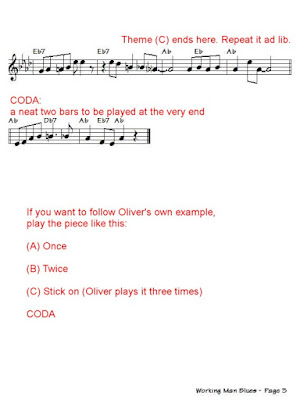At the time, King Oliver's Creole Jazz Band had a residency at Lincoln Gardens, 459, East 31st Street, Chicago - not far from the Lake. (As far as I can tell, there is today a glass office block on the site.) The band made a recording of Working Man Blues for the Gennett label in Richmond, Indiana, on 3 October 1923. You may listen to it BY CLICKING HERE.
It's a really good piece for the repertoire of our bands and easy to master.
As you see, there are just three short and simple sections. The first (A) is only a 12-bar blues, using a pretty riff. The second (B) is a 16-bar theme using The Four-Leaf Clover chord progression. (You can read about that progression BY CLICKING HERE.)
Section (B) is structured to include three opportunities for 2-bar breaks. Johnny Dodds makes the most of those in that 1923 recording.
The third 'theme' (C) involves free-style improvising over another 12-bar blues structure, but this time allowing a 'break' in bars 7 and 8. Oliver's band had the clarinet, cornet and trombone (Honoré Dutrey) respectively taking these breaks.
The tune is rounded off by a neat 2-bar CODA.
Some bands today, unlike Oliver himself, make more of Themes (A) and (B), staying on them for longer, or even dropping Theme (C) altogether.
Oliver chooses to devote the whole of the second half of the performance to three choruses of Theme (C).
Section (B) is structured to include three opportunities for 2-bar breaks. Johnny Dodds makes the most of those in that 1923 recording.
The third 'theme' (C) involves free-style improvising over another 12-bar blues structure, but this time allowing a 'break' in bars 7 and 8. Oliver's band had the clarinet, cornet and trombone (Honoré Dutrey) respectively taking these breaks.
The tune is rounded off by a neat 2-bar CODA.
Some bands today, unlike Oliver himself, make more of Themes (A) and (B), staying on them for longer, or even dropping Theme (C) altogether.
Oliver chooses to devote the whole of the second half of the performance to three choruses of Theme (C).
He was constrained by the limited amount of time for which a 78 rpm record could play. Bands today are freed from such constraint and - with more choruses - tend to make the tune last much longer. However, as I have said elsewhere, a short performance can often be more effective than a longer one (especially if the musicians have nothing special to 'say'). For me, Oliver's original recorded version feels just right.
On the choice of key, some bands today play the piece in F. It sounds fine in that key and is perhaps for some musicians a little easier than Lil Hardin and Oliver's choice of Ab.
To watch a clear and reverential performance of Working Man Blues by a much later band (The Peruna Jazzmen) CLICK HERE.
===========
The book Playing Traditional Jazz by Pops Coffee is available from Amazon.




